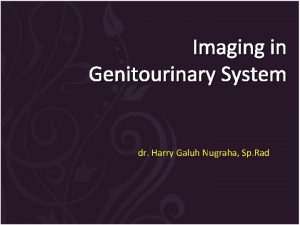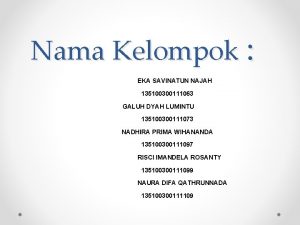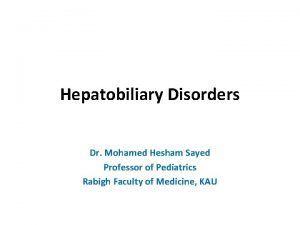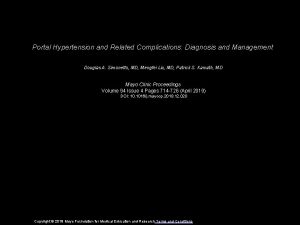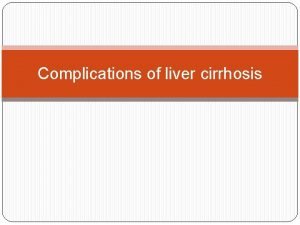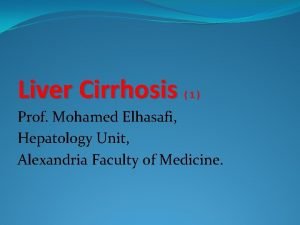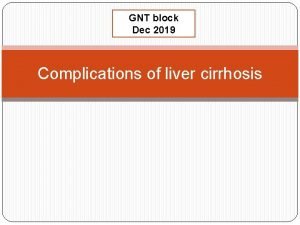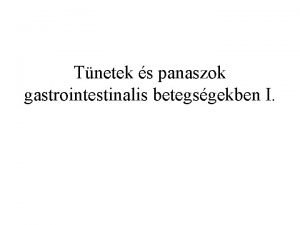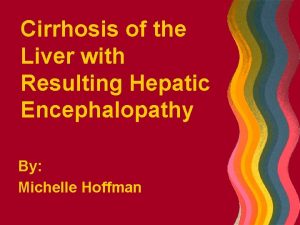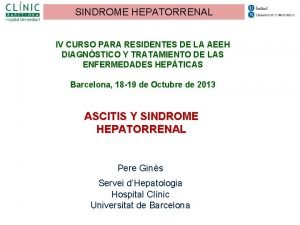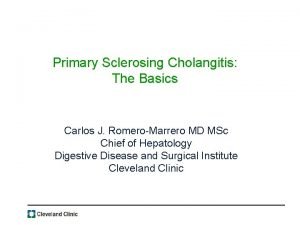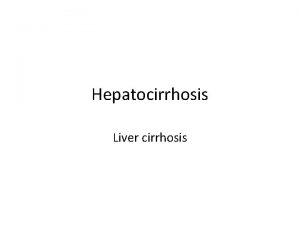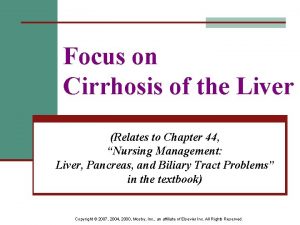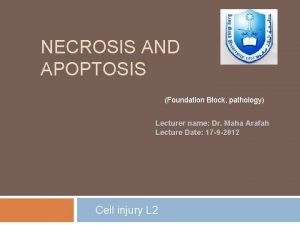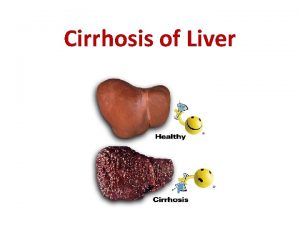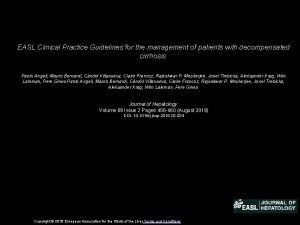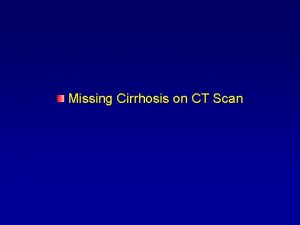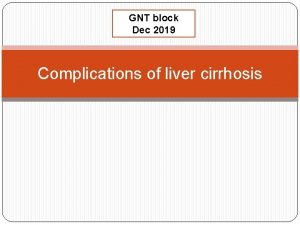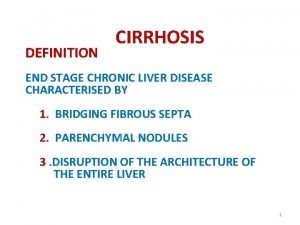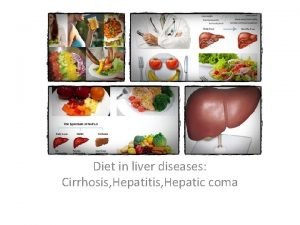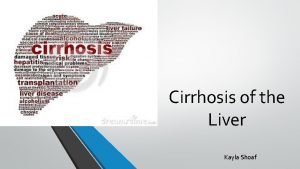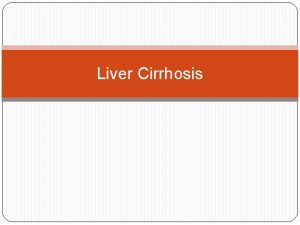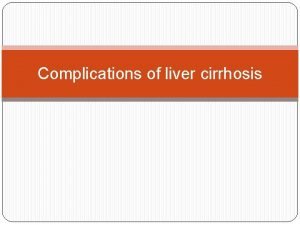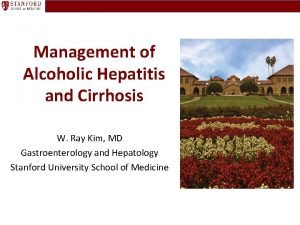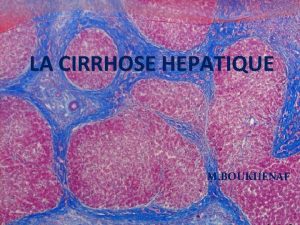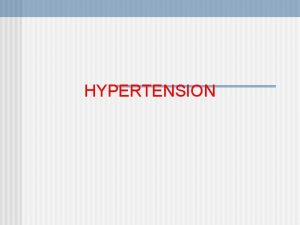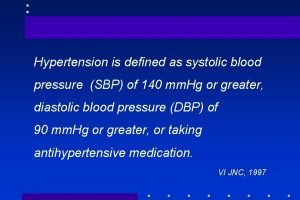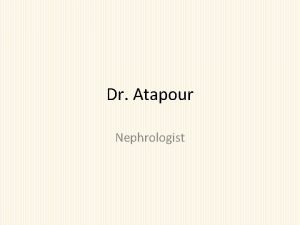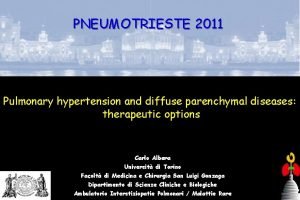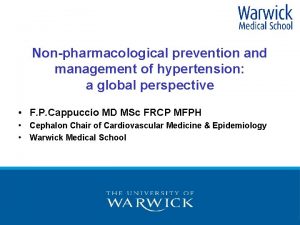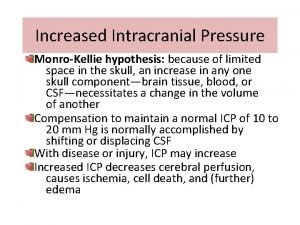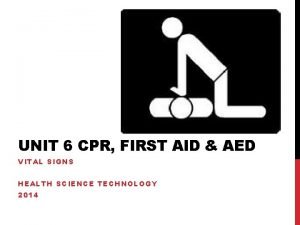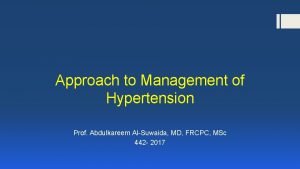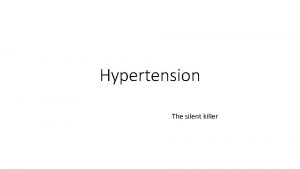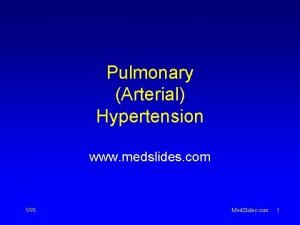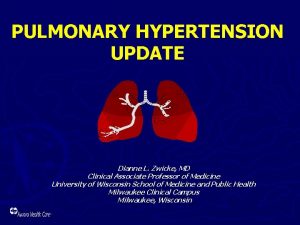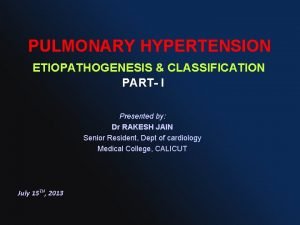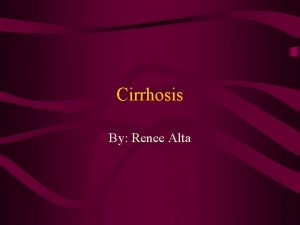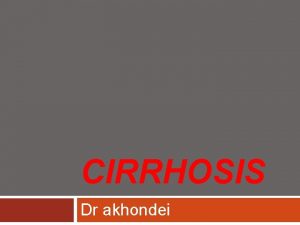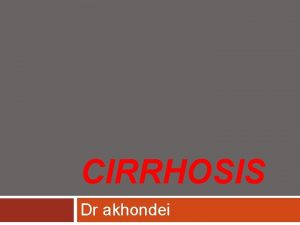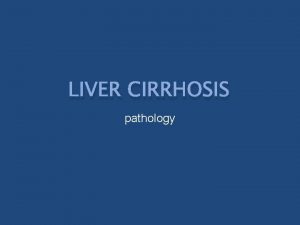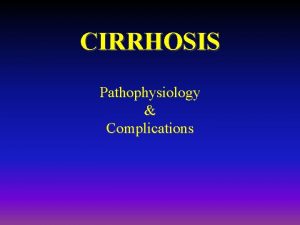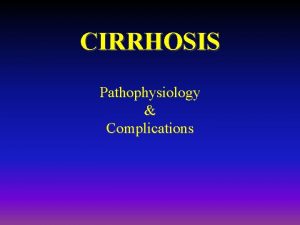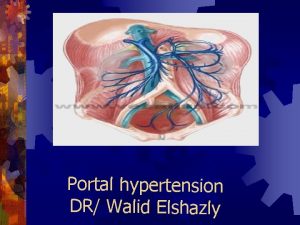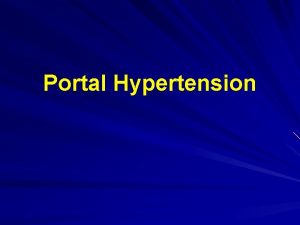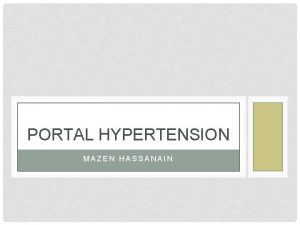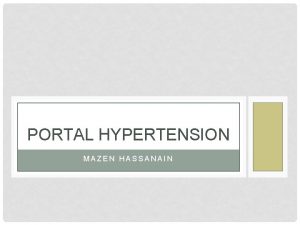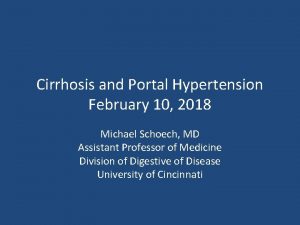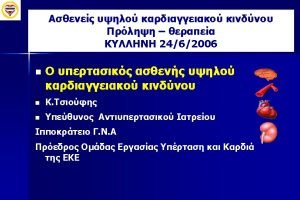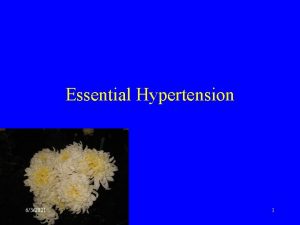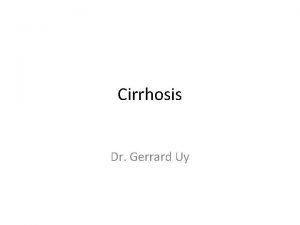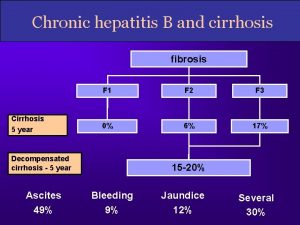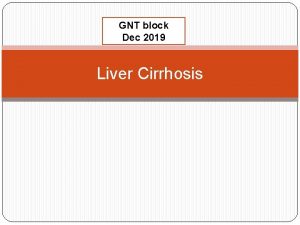Imaging of Cirrhosis Portal Hypertension dr Harry Galuh



















































- Slides: 51

Imaging of Cirrhosis & Portal Hypertension dr. Harry Galuh Nugraha, Sp. Rad Department of Radiology-Faculty of Medicine Padjadjaran University/Hasan Sadikin Hospital


Introduction v. Cirrhosis is derived from Greek word kirros=orange or tawny and osis=condition v. Term was 1 st coined by Laennec in 1826 v. Many definitions but common theme is injury, repair, regeneration and scarring

v. Primary histologic features: 1. Marked fibrosis 2. Destruction of vascular & biliary elements 3. Regeneration 4. Nodule formation

Definition • Cirrhosis is a pathological diagnosis. It is characterized by widespread fibrosis with nodular regeneration. Its presence implies previous or continuing hepatic cell damage

• WHO definition : a diffuse process characterized by liver necrosis and fibrosis and conversion of normal liver architechture into structurally abnormal nodules that lack normal lobular organization.



• Cirrhosis is common end result of many chronic liver disorders. • Diffuse scarring of liver – follows hepatocellular necrosis of hepatitis. • Inflammation – healing with fibrosis Regeneration of remaining hepatocytes form regenerating nodules. • Loss of normal architecture & function.

Etiology v v Alcohol (>70%) Chronic infections hepatitis C, B, B+D brucellosis, syphilis Chr. biliary obstruction Stricture, stones, cystic fibrosis, cong. b. atresia, ~cysts Autoimmune v v v Cardiovascular heart failure, pericarditis, Budd-Chiary-sy Metabolic/genetic errors Fe, Cu, α 1 -AT, lipids, Drugs and chemicals NASH Cryptogenic Combined

Anatomy




Pathophysiology Primary event is injury to hepatocellular elements Initiates inflammatory response with cytokine release->toxic substances Destruction of hepatocytes, bile duct cells, vascular endothelial cells Repair thru cellular proliferation and regeneration Formation of fibrous scar

Classification of Cirrhosis • WHO divided cirrhosis into 3 categories based on morphological characteristics of the hepatic nodules 1. Micronodular 2. Macronodular 3. Mixed

Micronodular Cirrhosis Nodules are <3 mm in diameter Relatively uniform in size Distributed throughout the liver Rarely contain portal tracts or efferent veins Liver is of uniform size or mildly enlarged Reflect relatively early disease

Macronodular & Mixed Cirrhosis • Nodules are >3 mm in diameter and vary considerably in size • Usually contain portal tracts and efferent veins • Liver is usually normal or reduced in size • Mixed pattern if both type of nodules are present in equal proportions

Multimodality imaging • Ultrasonography ( US ) • Computed Tomography Scan ( CT Scan) / Magnetic Resonance Imaging ( MRI )

US FEATURES Volume redistibution Coarse echotexture Noduler surface Nodules regenerative and dysplastic Portal Hypertension ascites, splenomegaly and varices

US SIGN OF LIVER CIRRHOSIS ARE • Increase echogenicity of liver parenchyma (due to associated fatty infiltration) • Irregular liver surface • Loss of normal liver architecture, i. e loss of visibility of hepatic blood vessels • Enlarged spleen • Enlarged posrtal vein>13 mm • Decreased or reversed portal vein flow on Doppler studies • Varices may be seen in the spelnic hilum and around the head of the pancreas, and the recanalized umbilical vein may be seen in the falciform ligament • Ascites




a b c Cirrhosis-spectrum of appearance: (a) Coarse parenchyma and innumerable tiny, hyperechoic nodules. (b) coarse parenchyma and innumerable, tiny hypoechoic nodules. (c) coarse parenchyma and surface nodularity.

d e f Cirrhosis-spectrum of appearance: (d) sagittal image showing an enormous caudate lobe (e) transverse sonogram shows that the right lobe is small and there is enlargement of the left lateral segment (f) subcostal oblique view showing a tiny right lobe (g to i) of the liver, which is separated from the large left lobe by the main lobar fissure (arrows).

Hepatic vein strictures-cirrhosis: (a). Gray-scale image of hepatic vein shows a tapered luminal narrowing (b) Color Doppler image shows appropriately directed flow toward the inferior vena cava in blue. There is color aliasing from the rapid velocity flow through the points of narrowing

Congestive-cirrhosis: The liver still has a normal parenchymal echo pattern, but note the curved, bulging inferior border and the tiny breaks in the capsule (arrows). A=ascites

CT SIGN OF LIVER CIRRHOSIS INCLUDE • Irregular contour • Decreased density with fatty changed or increased density with haemochromatosis • Enlarged caudate lobe • Enlarged spleen • Varices: discrete round or tubular structures that enhance with contrast • Ascites

Portal Hypertension (PH) Definition: it is an increase in portal venous pressure. Portal vein pressure above the normal range of 5 to 8 mm Hg Portal vein - Hepatic vein pressure gradient greater than 5 mm Hg (>12 clinically significant) Represents an increase of the hydrostatic pressure within the portal vein or its tributaries


CT Liver Cirrhosis with portal hypertension

Pathophysiology of PH Cirrhosis results in scarring (perisinusoidal zdeposition of collagen) Scarring narrows and compresses hepatic sinusoids (fibrosis) Progressive increase in resistance to portal venous blood flow results in PH Portal vein thrombosis, or hepatic venous obstruction also cause PH by increasing the resistance to portal blood flow


Pathophysiology of PH As pressure increases, blood flow decreases and the pressure in the portal system is transmitted to its branches Results in dilation of venous tributaries Increased blood flow through collaterals and subsequently increased venous return cause an increase in cardiac output and total blood volume and a decrease in systemic vascular resistance With progression of disease, blood pressure usually falls

Portal Vein Collaterals Coronary vein and short gastric veins -> veins of the lesser curve of the stomach and the esophagus, leading to the formation of varices Inferior mesenteric vein -> rectal branches which, when distended, form hemorrhoids Umbilical vein ->epigastric venous system around the umbilicus (caput medusae) Retroperitoneal collaterals ->gastrointestinal veins through the bare areas of the liver


Etiology of PH Causes of PH can be divided into 1. Pre-hepatic 2. Intra-hepatic 3. Post-hepatic

Pre-hepatic PH Caused by obstruction to blood flow at the level of portal vein Examples: congenital atresia, extrinsic compression, schistosomiasis, portal, superior mesenteric, or splenic vein thrombosis

Post-hepatic Caused by obstruction to blood flow at the level of hepatic vein Examples: Budd-Chiari syndrome, chronic heart failure, constrictive pericarditis, vena cava webs

Complications of PH GI bleeding due to gastric and esophageal varices Ascites Hepatic encephalopathy

Varices Most life threatening complication is bleeding from esophageal varices Distal 5 cm of esophagus Usually the portal vein-hepatic vein pressure gradient >12 mm Hg Bleeding occurs in 25 -35% of pts. With varices and risk is highest in 1 st yr.


US finding of PH • Secondary signs of splenomegaly, ascites, and portosystemic-venous collateral • Five major sites of portosystemic venous collaterals are visualized by US: – – – Gastroesophageal junction Paraumbilical vein Splenorenal dan gastrorenal veins Intestinal-retroperitoneal anastomoses Hemorrhoidal veins

Portal Hypertension a d b e c f a. Recanalized paraumbilical vein b. Enlarged coronary vein c. Extensive varices d. Extensive varices e. Sphlenic hilar varices f. Sphlenic hilar varices

Portal hypertension: Recanalized paraumbilical vein

Portal Hypertension: Enlarged coronary vein

Portal Hypertension: Extensive varices

Portal Hypertension: Sphlenic hilar varices

Conclusion Ultrasound the first investigation Liver cirrhosis commonly leads to a shrunken irregular liver with splenomegaly and ascites CT/MRI more sensitive than US in detecting HCC in patients with cirrhosis CT & MRI superior to US, both in lession detection and characterization

Thank U
 Hydrosalpynx
Hydrosalpynx Frc control system
Frc control system Galuh wilujeng saraswati
Galuh wilujeng saraswati Galuh dyah
Galuh dyah Portal hypertension signs
Portal hypertension signs Portal hypertension definition
Portal hypertension definition Nursing management of portal hypertension
Nursing management of portal hypertension Portal hypertension mayo clinic
Portal hypertension mayo clinic Complications of cirrhosis
Complications of cirrhosis Difference between cld and dcld
Difference between cld and dcld Presinusoidal portal hypertension
Presinusoidal portal hypertension Complication of liver cirrhosis
Complication of liver cirrhosis Gastrointestinalis
Gastrointestinalis Liver cirrhosis stages
Liver cirrhosis stages Terlipressin
Terlipressin Simtuzumab
Simtuzumab Hepatochirrosis
Hepatochirrosis Pathophysiology of cirrhosis of liver
Pathophysiology of cirrhosis of liver Necrotic cell
Necrotic cell What is cirrhosis
What is cirrhosis Easl clinical practice guidelines
Easl clinical practice guidelines Can ct scan miss cirrhosis
Can ct scan miss cirrhosis Hyperestrinism cirrhosis
Hyperestrinism cirrhosis Chronic liver desease
Chronic liver desease Diet for hepatitis c
Diet for hepatitis c Pes statement for liver cirrhosis
Pes statement for liver cirrhosis Primary biliary cholangitis skin
Primary biliary cholangitis skin Is cirrhosis treatable
Is cirrhosis treatable Pes statement for liver cirrhosis
Pes statement for liver cirrhosis Complication of liver cirrhosis
Complication of liver cirrhosis Cirrhosis care near woodland
Cirrhosis care near woodland Alcoholic liver disease
Alcoholic liver disease Micronodular cirrhosis vs macronodular
Micronodular cirrhosis vs macronodular Hematocrit
Hematocrit Hypertensive urgency vs emergency
Hypertensive urgency vs emergency Causes of secondary hypertension
Causes of secondary hypertension Pneumotrieste
Pneumotrieste Non pharmacological management of hypertension
Non pharmacological management of hypertension Fiber optic ventricular bolt catheter
Fiber optic ventricular bolt catheter 6 vital signs first aid
6 vital signs first aid Case scenario for hypertension
Case scenario for hypertension Pico question examples labor and delivery
Pico question examples labor and delivery Gestational hypertension
Gestational hypertension Sbp179
Sbp179 Definition of hypertension
Definition of hypertension Jnc 8 classification of hypertension
Jnc 8 classification of hypertension Medslide
Medslide Pulmonary hypertension
Pulmonary hypertension Chief complaint present illness
Chief complaint present illness Diagnosing hypertension
Diagnosing hypertension Pulmonary hypertension causes
Pulmonary hypertension causes Hypertension vs hypotension
Hypertension vs hypotension
